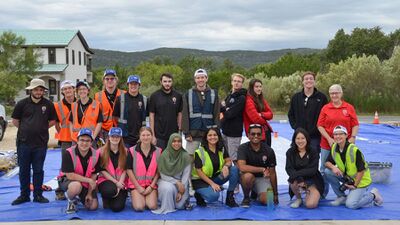NS-122: Difference between revisions
No edit summary |
No edit summary |
||
| Line 2: | Line 2: | ||
[[File:Team_picture.jpg| | [[File:Team_picture.jpg|400px|Image:400 pixels]] | ||
The UMD Nearspace Team successfully launched two balloons during the annular solar eclipse on Saturday, 14 October 2023. The winds were not as bad as predicted, so we managed to inflate both balloons inside an open wind-break constructed in the driveway of our Airbnb. The first balloon was released right after the beginning of our launch window around 10:35 AM and then the second balloon almost immediately afterwards at 10:45 AM. | The UMD Nearspace Team successfully launched two balloons during the annular solar eclipse on Saturday, 14 October 2023. The winds were not as bad as predicted, so we managed to inflate both balloons inside an open wind-break constructed in the driveway of our Airbnb. The first balloon was released right after the beginning of our launch window around 10:35 AM and then the second balloon almost immediately afterwards at 10:45 AM. | ||
Revision as of 12:17, 17 October 2023
NS-122 Eclipse Launch Summary
 The UMD Nearspace Team successfully launched two balloons during the annular solar eclipse on Saturday, 14 October 2023. The winds were not as bad as predicted, so we managed to inflate both balloons inside an open wind-break constructed in the driveway of our Airbnb. The first balloon was released right after the beginning of our launch window around 10:35 AM and then the second balloon almost immediately afterwards at 10:45 AM.
The UMD Nearspace Team successfully launched two balloons during the annular solar eclipse on Saturday, 14 October 2023. The winds were not as bad as predicted, so we managed to inflate both balloons inside an open wind-break constructed in the driveway of our Airbnb. The first balloon was released right after the beginning of our launch window around 10:35 AM and then the second balloon almost immediately afterwards at 10:45 AM.
The first balloon to be released was the Eclipse Balloon carrying the UMD Vent System (to achieve float), an Iridium unit & Occams board (for tracking), Pterodactyl (sensor suite for atmospheric science data), an Insta360 panoramic camera, and the Streaming Video system. The balloon ascended through 60,000 ft and the vent was commanded to open, but unfortunately when the vent was subsequently commanded to close, there was latency in the system resulting in too much helium being vented. Fortunately, even though the balloon was descending, it was still in the air during maximum occultation so there's hope that we may have gotten some good video. The Pterodactyl payload and tracking system both worked well on this flight string which landed in a deer lease hunting area. A couple of hunters saw the payload string and brought it out and back to their home before calling us - needless to say we were tracking it the whole way and were very appreciative when they gave it back!
The second balloon was the UMD balloon carrying a number of unique payloads: GHOUL (UMD vent system), Command (tracking and data module), RFD900 (an eclipse payload downlinking telemetry in flight), more cameras (another Insta 360 and panoramic camera), and MCAT (Methane sensing payload). This balloon was supposed to ascend to about 78,000 ft, and then achieve float, but, again most likely because of a lag time between sending a command and receiving it, the vent did not open and the balloon did not float but instead continued ascending to burst at about 92,000 ft. After burst, the balloon, the neck insert, and a tether line that had gotten stuck, all managed to wrap around the parachute, resulting in a fast descent and a hard landing that destroyed a number of payloads. The landing was just on the inside of a cattle ranch, so the game warden was called and the property owner contacted, and both ended up being helpful in recovering our payloads.
Even though we have not fully assessed the status of the payloads or the quality of data obtained during this eclipse, the team is proud to have launched two balloons in quick succession, tracked them to landing and beyond, and recovered both payload strings. The launch operation went smoothly, both balloons were released during the launch window, and overall the team worked well together, the recovery was very lucky, and we definitely learned a lot! All of the lessons learned will be acted upon for the next eclipse in approximately 6 months – the total eclipse on Monday, 8 April 2024.
Balloon Launch Details
When:
Saturday 14 October 2023
Eclipse Balloon Release 10:35 AM
UMD Balloon Release 10:45 AM
Launch Site:
520 Mountain Valley Road
(Our Airbnb Driveway!)
Concan, Texas 78838
Landing Sites: Eclipse Payload String landed in a Deer Lease UMD Payload String landed on a Cattle Ranch Both NorthWest of San Antonio
Future Updates
All of the data from this flight will be uploaded and accessible for anyone interested. Please contact Dr. Mary Bowden for more information if needed.
Our video live stream should still be on YouTube at the following link: UMD Live Stream Link Our channel name is UMD Nearspace.